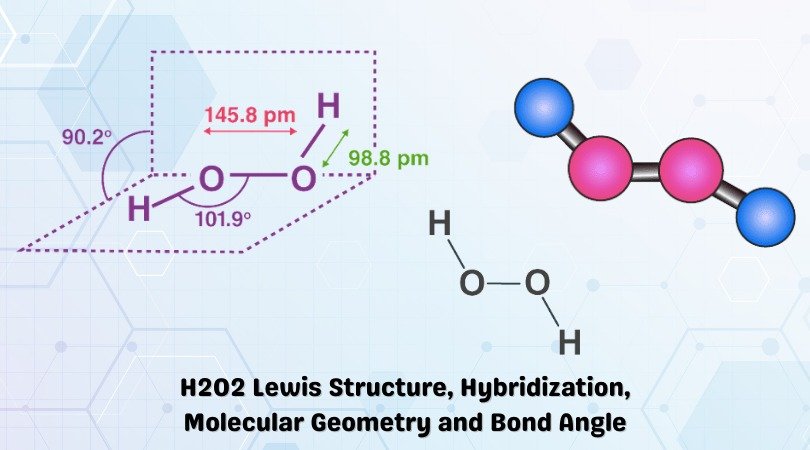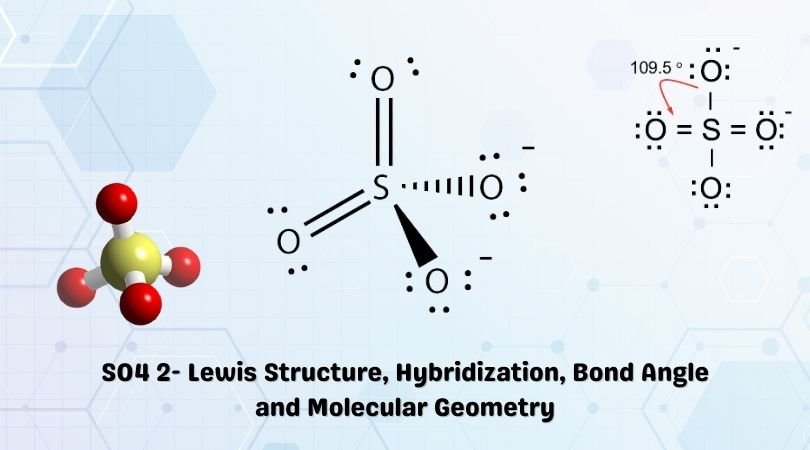SCN- is an anion having a chemical name – Thiocyanate. The ion is the conjugate base of thiocyanic acid ( HSCN). There are common derivatives for the compound, which include potassium thiocyanate and sodium thiocyanate. The ion is made up of three atoms: Sulphur, Carbon and Nitrogen.
| Name of molecule | Thiocyanate (SCN-) |
| No of Valence Electrons in the molecule | 16 |
| Hybridization of SCN- | sp hybridization |
| Bond Angles | 180° |
| Molecular Geometry of SCN- | Linear |
The ion has a negative charge as it accepts one valence electron. In this blog post, we will look at the Lewis Structure, Molecular Geometry and shape of the molecule.
Contents
SCN- Valence electrons
To draw a Lewis structure for any molecule or ion, it is essential to know its total number of valence electrons. These electrons participate in the bond formation and help us understand the Lewis structure better.
In SCN-, there are three atoms present in the structure: Sulphur, Carbon and Nitrogen. So we will look at the number of valence electrons for each atom individually and then add all the electrons to find the total number of valence electrons for SCN anion.
Carbon has four valence electrons in its outer shell.
Nitrogen has five valence electrons in its outer shell.
Sulphur has six valence electrons that can participate in bond formation.
And as there is a -1 charge on Thiocyanate, it means it accepts one extra valence electron, so we will also add that up.
Total valence electrons for SCN- : 4+5+6+1
= 16
Hence, SCN- has a total of 16 valence electrons.
SCN- Lewis Structure
The Lewis structure for any molecule helps us understand the arrangement of valence electrons and atoms in the structure. The valence electrons present in the outer shell of all atoms participate in forming bonds or lone pairs. The ones that form bonds are called bonding pairs of electrons, and the ones that do not form bonds are referred to as non-bonding pairs of electrons.
To know the Lewis Structure, we must
Know the number of valence electrons.
Determine the central atom.
Arrangement of all the atoms in the structure
We already know the number of valence electrons for SCN- ion. So we proceed to find out the central atom for the ion. Here we have three types of atoms: Sulphur, Carbon and Nitrogen. Generally, the atom that is least electronegative takes the central position. For SCN-, the least electronegative atom is Carbon. And hence, the Carbon atom will take the central position.
Sulphur and Nitrogen atoms will be placed around Carbon like this:
S C N
Once we know the arrangement of atoms in the structure, we can start arranging the valence electrons. Carbon has four valence electrons, but as it will form a bond with both the atoms, let’s first look at the electrons for the two atoms.
Place single bonds between Sulphur and Carbon along with Nitrogen and Carbon to check if the octets are complete. Each bond requires a pair of electrons, and here we have used up four valence electrons out of 16.
S-C-N
If you look at the atoms individually with the rest of the valence electrons, you will find out that the octets are yet not complete for any of these atoms. So now make double bonds on both sides and arrange the rest of the electrons to see if we have a stable structure/
S=C=N
Two double bonds use up eight valence electrons which means we are left with only eight more valence electrons. Carbon will have a complete octet as it is sharing all its four valence electrons with both the atoms.
Rest four valence electrons will be arranged around Nitrogen and Sulphur. Nitrogen will have two lone pairs of electrons, and Sulphur will also have two lone pairs of electrons to have a complete octet.
This is the most acceptable Lewis Structure for SCN-. If you calculate the formal charges on all the atoms for this structure, Sulphur will have a -1 charge, and the rest two atoms that is Carbon and Nitrogen will have zero charges.
However, it also has a resonance structure as the lone pairs of electrons keep on shifting and forming bonds.
SCN- Resonance Structures
SCN- anion has resonance structures as the bonds keep shifting due to the presence of two lone pairs on both atoms. The first structure has two double bonds on both sides, as mentioned above.
The second structure has a triple bond between Carbon and Nitrogen atom and a single bond between the Carbon and Sulphur atom. For this structure, the formal charge on the Sulphur atom has a -1 charge, and the rest of the atoms have zero charges.

The third resonance structure has a triple bond between Carbon and Sulphur atom and a single bond between Carbon and Nitrogen atom. In this structure, the central atom has a zero charge; Sulphur has a charge of +2, and Nitrogen has a charge of -1. In total, the ion has a charge of -1.
The first two resonance structures are more frequently used as it is more relevant. However, the first structure is more stable and often used as the Lewis structure representation for SCN ion.
SCN- Hybridization
To determine the hybridization for the SCN- molecule, we will look at the number of lone pairs and the number of atoms bonding with the central atom.
Carbon forms bonds with two atoms and has no lone pairs, which means there are two regions of electron density. And the molecules with two-electron density regions have sp hybridization.
Thus, the Thiocyanate ion has sp hybridization.
SCN- Molecular Geometry
The molecular geometry of any molecule or compound can be determined by looking at the arrangement of atoms in the structure. We can also use the AXN notation method to find out the geometry of the molecule.
A is the central atom, X is the number of atoms bonded to the central atom, and N is the number of lone pairs of electrons.
For SCN- ion, Carbon is the central atom, and it is forming bonds with two atoms – Nitrogen and Sulphur. There are no lone pairs in the molecule; hence it has AX2 notation, resulting in the linear molecular geometry.
Also, if you look at the arrangement of atoms in the molecule, all the atoms are arranged in a straight line, which confirms that it has a linear molecular geometry.

SCN- Bond Angle
Thiocyanate ion has a linear geometry, and as all atoms are arranged in a straight line, the bond angle is 180°.
SCN- Shape
When we look at the molecule and the arrangement of atoms in it, we can see that all atoms are arranged in the same plane. The atoms are arranged in a linear fashion, making SCN a linear-shaped molecule.
One can also determine the shape of the molecule using the VSEPR theory, in which the number of bonded electron pairs present on the central atom can help you determine the shape of the molecule. For SCN ion, there are two bonded pairs of an electron and no lone pairs, which means it is a linear ion.
Concluding Remarks
To summarize this blog post on SCN-, we can say the following:
- It is made up of three atoms: Sulphur, Carbon and Nitrogen.
- There are a total of 16 valence electrons for the SCN ion.
- The central Carbon atom forms double bonds with both the atoms and in its resonance structures, there is one triple bond and one single bond in the structure.
- There are no lone pairs of electrons on the central atom.
- Carbon has an sp hybridization with a bond angle of 180°.
- It is a linear-shaped molecule.




